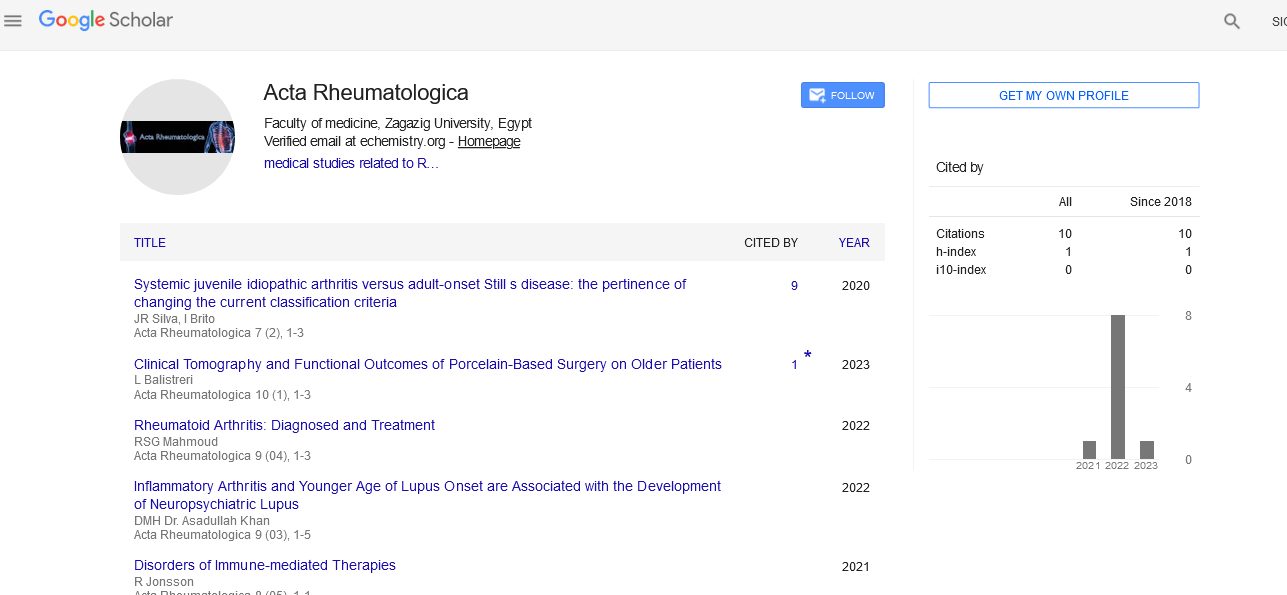Perspective - (2025) Volume 12, Issue 1
Muscle Weakness: Causes, Diagnosis, and Treatment
Maurizio Marogna*
Department of Reumatology, University of Bari Aldo Moro, Bari, Italy
*Correspondence:
Maurizio Marogna, Department of Reumatology, University of Bari Aldo Moro, Bari,
Italy,
Email:
Received: 17-Feb-2025, Manuscript No. IPAR-25-15554;
Editor assigned: 20-Feb-2025, Pre QC No. IPAR-25-15554 (PQ);
Reviewed: 07-Mar-2025, QC No. IPAR-25-15554;
Revised: 14-Mar-2025, Manuscript No. IPAR-25-15554 (R);
Published:
24-Mar-2025
Introduction
Muscle weakness, also known as myasthenia, is a condition
characterized by a reduced ability of muscles to generate force.
It can affect people of all ages and may be temporary or chronic,
depending on the underlying cause. Muscle weakness can arise
from a variety of factors, including neurological disorders,
muscular diseases, metabolic conditions, and lifestyle factors.
Understanding the causes, symptoms, and treatments of muscle
weakness is essential for maintaining overall health and
preventing complications.
Description
Causes of muscle weakness
Muscle weakness can result from multiple medical conditions
and external factors. The most common causes include:
Neuromuscular disorders
Myasthenia gravis: An autoimmune disorder that affects the
communication between nerves and muscles, leading to fatigue
and muscle weakness.
Multiple Sclerosis (MS): A neurological disease that affects
the central nervous system and impairs muscle coordination and
strength.
Amyotrophic Lateral Sclerosis (ALS): A progressive
neurodegenerative disease that leads to muscle atrophy and
weakness.
Peripheral neuropathy: Damage to peripheral nerves that can
cause muscle weakness, numbness, and tingling sensations.
Muscular disorders
Muscular dystrophy: A group of genetic disorders that lead to
progressive muscle degeneration and weakness.
Polymyositis and dermatomyositis: Inflammatory conditions
that cause muscle weakness, often accompanied by skin rashes.
Metabolic and endocrine conditions
Hypothyroidism: An underactive thyroid can lead to muscle
weakness, fatigue, and weight gain.
Diabetes: Uncontrolled blood sugar levels can result in muscle
weakness due to nerve damage (diabetic neuropathy).
Electrolyte imbalances: Low levels of potassium, calcium, or
magnesium can interfere with muscle function and cause
weakness.
Infectious diseases
Lyme disease: A bacterial infection that can lead to
neurological symptoms, including muscle weakness.
Polio: A viral infection that affects the nervous system and
causes muscle paralysis and weakness.
Guillain-Barré syndrome: An autoimmune disorder triggered
by infections that leads to rapid-onset muscle weakness and
paralysis.
Lifestyle and environmental factors
Sedentary lifestyle: Lack of physical activity can lead to
muscle deconditioning and weakness.
Malnutrition: Deficiencies in essential nutrients such as
protein, vitamin D, and B vitamins can impair muscle function.
Overuse and injury: Repetitive strain or muscle overuse can
lead to temporary weakness and fatigue.
Symptoms of muscle weakness
Muscle weakness can manifest in different ways depending
on the underlying cause. Common symptoms include:
• Difficulty lifting objects or climbing stairs.
• Frequent muscle cramps or spasms.
• Loss of balance and coordination.
• Fatigue and muscle pain after minimal exertion.
• Gradual or sudden onset of weakness in specific muscle groups.
• Drooping eyelids (in conditions like myasthenia gravis).
• Trouble swallowing or speaking in severe cases.
• Diagnosis of muscle weakness.
Diagnosing muscle weakness involves a comprehensive
medical evaluation that includes:
Medical history and physical examination
A doctor will assess the patient's symptoms, medical history,
and lifestyle factors to identify potential causes.
Laboratory tests
Blood tests: Check for infections, inflammation, electrolyte
imbalances, and hormonal disorders.
Genetic testing: Helps diagnose inherited muscular disorders
like muscular dystrophy.
Electromyography (EMG) and nerve conduction
studies
These tests evaluate nerve and muscle function to detect
neuromuscular disorders.
Imaging studies
MRI or CT scans: Used to identify structural abnormalities in
the brain, spinal cord, or muscles.
Muscle biopsy
A small tissue sample is examined under a microscope to
diagnose muscular disorders.
Treatment of muscle weakness
The treatment of muscle weakness depends on the
underlying cause. Common treatment approaches include:
Medications
Corticosteroids and immunosuppressants: Used for
autoimmune conditions like myasthenia gravis and polymyositis.
Thyroid hormone therapy: Prescribed for hypothyroidism-related
muscle weakness.
Pain relievers and muscle relaxants: Help manage discomfort
and spasms.
Physical therapy
Strength training exercises: Helps rebuild muscle strength and
endurance.
Stretching and flexibility exercises: Prevents stiffness and
improves mobility.
Balance and coordination training: Reduces the risk of falls
and improves movement control.
Nutritional support
Protein-rich diet: Essential for muscle repair and growth.
Vitamin and mineral supplements: Ensure adequate intake of
essential nutrients like vitamin D, calcium, and magnesium.
Lifestyle modifications
Regular exercise: Helps maintain muscle function and prevent
atrophy.
Adequate rest and recovery: Prevents overexertion and
muscle fatigue.
Stress management techniques: Reduces the impact of
conditions like multiple sclerosis and autoimmune disorders.
Advanced therapies
Stem cell therapy: An emerging treatment for muscular and
neurological conditions.
Nerve stimulation therapy: Helps restore nerve function in
certain cases.
Prevention of muscle weakness
Although some causes of muscle weakness cannot be
prevented, adopting a healthy lifestyle can reduce the risk of
developing the condition:
• Maintain a balanced diet with adequate nutrients.
• Engage in regular physical activity to keep muscles strong.
• Stay hydrated to prevent muscle cramps and dehydration-related weakness.
• Manage underlying health conditions like diabetes and thyroid disorders effectively.
• Avoid prolonged bed rest and immobility to prevent muscle atrophy.
Conclusion
Muscle weakness is a common symptom that can result from
various medical conditions, lifestyle factors, and neurological
disorders. Early diagnosis and appropriate treatment are crucial
for managing symptoms and improving quality of life. By
adopting a proactive approach, including proper nutrition,
exercise, and medical interventions, individuals can maintain
muscle strength and function, reducing the impact of muscle
weakness on daily activities. Advances in research and treatment
options continue to offer hope for individuals affected by muscle
weakness, paving the way for improved therapeutic outcomes in
the future.





